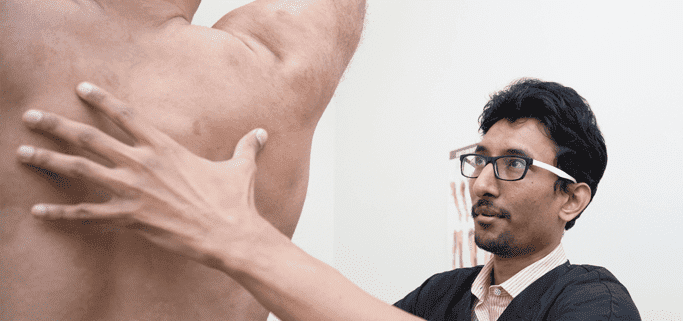September 26, 2017

In most cases muscle knots, often called myofascial trigger points, are nothing more than a mere annoyance, causing mild to moderate pain when pressure is applied. However, depending on their location, muscle knots can cause referred pain in other areas of your body that is easy to misdiagnose.
The cells of each of your muscles are encased in a sheath of connective tissue called fascia. You have probably encountered fascia while eating a steak. The fascia separates one muscle from its neighbor, reducing friction and protecting and supporting nerves and blood vessels that pass between muscles.
When you are chronically dehydrated and sedentary, your muscles become stiff and lose some of their elasticity. Your muscle fibers may begin to adhere to one another, creating hard lumpy knots. They may appear on your upper back, neck and shoulders, as a result of placing strain on those muscles as you sit all day long.
Muscle knots can also be the result of injury or overuse. If you are an athlete, or regularly participate in activities like CrossFit or resistance training, overuse of your muscles can cause micro-tears in your muscle fascia. Because muscle repairs itself with collagen, causing scar tissue, you can create muscle knots in damaged areas. Muscle knots from physical activity often occur in the belly of the muscles of your extremities.
Muscle knots can elicit a perpetual state of muscle contraction, which can compress and entrap nerves, leading to secondary symptoms. Eventually, as the muscle loses its functional capacity, other muscles may be recruited to take up the slack, causing mechanical deficiencies that can lead to further injury.
Over time, if muscle knots are ignored, they can reduce mobility and cause referred pain in other areas of your body.
There are many things you can do to prevent, relieve, and eliminate muscle knots, both through lifestyle change and therapeutic intervention.
Hydration: When optimally hydrated, muscles are about 75 percent water. Water enables your muscles to glide smoothly during contraction by creating inter fiber distance between muscle cells. When muscles are dehydrated, inter fiber space is decreased and muscles fibers can become sticky and adhere to one another, creating muscle knots. Consuming too much alcohol, caffeine and soda, and eating processed foods contributes to dehydration. Drink two to three liters of plain filtered water daily for optimal hydration. Eat plenty of fresh whole fruits and vegetables, which are full of water and micronutrients.
Stretching: One of the primary properties of muscle tissue is elasticity. Much like rubber bands, your muscles are capable of stretching, and then returning to their original length. However, when muscles are underused, as in a sedentary lifestyle, they become stiff and inelastic, which can lead to the formation of muscle knots. A regular daily stretching routine like yoga will loosen up your muscles and restore elasticity.
Vigorous physical activity: Your muscles were designed to shorten and lengthen regularly, on a daily basis. When you do exercises that move your joints through their full range of motion, your joints and muscles benefit, not only from the movement, but from the rich supply of oxygen and nutrients that are delivered through your bloodstream to your muscle tissue.
If muscle knots are persistent, and especially if they are causing pain, therapeutic treatment may be in order. Therapy may entail massage, stretching and prescribed exercises to help eliminate muscle knots and prevent their return. Your therapist may also analyze your posture, gait and muscle balance to identify motor deficiencies that are at the root of your muscle knots.
The sports injury specialists at NYDNRehab will quickly and accurately identify and diagnose the location and cause of your muscle knots, and will work with you to restore your muscles to full functionality. Contact NYDNRehab today, and put yourself on the road to pain-free and fully functional recovery from muscle knots.
Dr. Lev Kalika is a world-recognized expert in musculoskeletal medicine. with 20+ years of clinical experience in diagnostic musculoskeletal ultrasonography, rehabilitative sports medicine and conservative orthopedics. In addition to operating his clinical practice in Manhattan, he regularly publishes peer-reviewed research on ultrasound-guided therapies and procedures. He serves as a peer reviewer for Springer Nature.
Dr. Kalika is an esteemed member of multiple professional organizations, including: